9. How do you handle: EDUCATION and FULFILLMENT?
Schooling
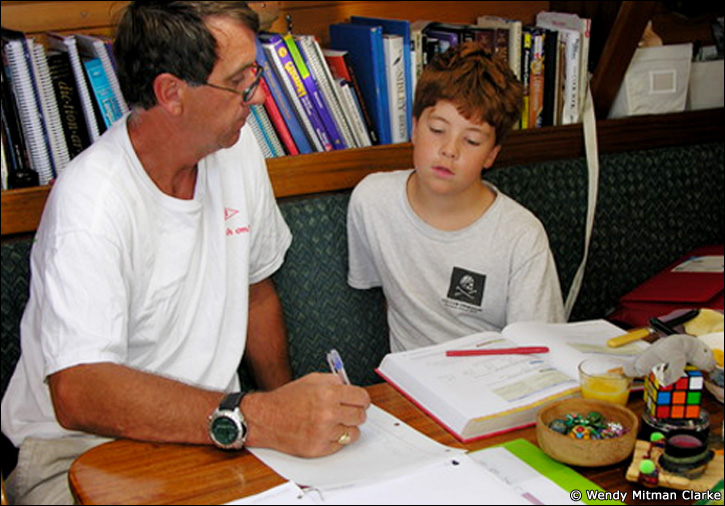 |
| Math class |
Wendy
I've alluded to school a few times already, which just goes to show how big a part of our lives it is.
We have always felt that our success at cruising depends first and foremost on the kids' success in school. If home schooling is not working, then we have to come up with another way, and if that means quitting cruising, so be it. Bluntly put, the kids' education has to come first.
We want our kids to have a strong enough home school education that they can return seamlessly (academically at least) into a traditional classroom at or above grade level, if we were to choose that option. There's no question that by simply being out here, the kids are getting an education like no other. But they still have to be able to read, write, and do arithmetic (and algebra, and geometry, and geography, and history, and science) to be able to attend college and be successful in the world. That's just our philosophy; everyone does it differently.
We use the Calvert School system.
The first year, we used their ATS program, which assigns a teacher to assess the kids' tests and papers every 20 lessons (180 lessons constitutes the school year). This was useful for us as teacher/parents who were not professional educators. It helped us have a benchmark for both kids and make sure they were on track and that we, as teachers, were doing what we needed to do.
But we began to feel like the tests were running our lives, and everyone was stressing out too much about them. So this year we are going with the same Calvert Academic curriculum but no ATS; we oversee all the tests and papers ourselves. This gives us more flexibility, which we all needed. It's a lot smoother and everyone is a lot happier.
Calvert is a rigorous curriculum and we like that. It's very structured, and we like that too. That takes some of the burden off us as teachers to say, “You have to do this.” If the school says it has to be done, it has to be done, and there's no arguing with it.
I had another parent ask me, “How do you get them to do school every day?” as if this were some great mystery. I said, “We tell them, it's time for school.” It has to get done. |
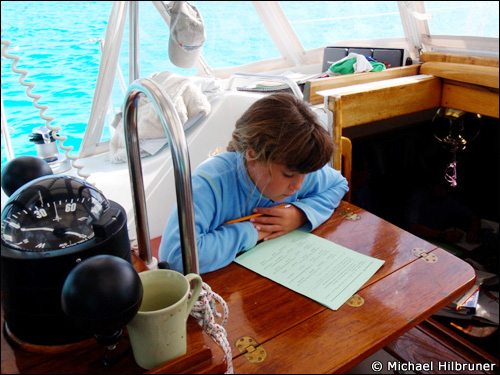 |
| Kailani works on a test. |
Our kids are great students. They're disciplined and work hard, but this also comes from the top down. As teachers, we have to be disciplined too.
Sometimes it's frustrating as an adult, to not be able to just have the day to yourself or do what other people are doing.
But not often. Usually, it's incredibly fulfilling to watch your child learn, and to connect with him or her in that way. It's a real privilege, honestly. And you get to know each other and learn to communicate in ways that can only help as they grow older, and life gets more complex. We all had a hard time at first, and there were days when we truly struggled and I left the boat crying my eyes out in frustration.
The lessons we have learned have been many when it comes to school.
- Be patient.
- Remember that you're the teacher, not the mom or dad. There's a huge difference.
- As the student, remember that you're the student, not the son or daughter. There's a huge difference there too.
- Don't let emotions and expectations get involved.
- If your kid is having a bad day, give him a break. If you are having a bad day, give both of you a break.
|
But we have all learned, and as we've learned it's been gratifying to watch our kids take off.
Although Calvert is very structured, we often go off on tangents with one or both of them if something really catches their interest.
A basic history lesson may turn into an hour-long diversion into the differing theologies of the world's major religions, and then to whether building a mosque close to Ground Zero in New York City is a good thing or not. Which leads into a discussion of the Bill of Rights, and the idea of freedom of religion, and how the ideas of the founding fathers are in practice (or not) today. Usually when one of these conversations takes off, both kids get in on it. And often we end up talking about it later, over dinner.
And of course, the field trips are awesome.
John
As the Army used to say: It's the toughest job you'll ever love. Teaching my kids has been the hardest thing I have ever done, yet one of the most satisfying things I have ever done.
It teaches you patience. There are days when as opposed to getting angry with my students, I say, that is enough, because I know the next day they will be on the top of their game and will rip through two lessons. But it took a long time to learn that. And our best friends say we're getting smarter every day!
Also, be creative. Look at your boat. It is an awesome teaching platform. Friendships and social interactions
This is complicated.
Our kids are very close, but as they grow older I can see that they need more of their own kind, so to speak. We actively seek out other cruising families to try to meet those needs.
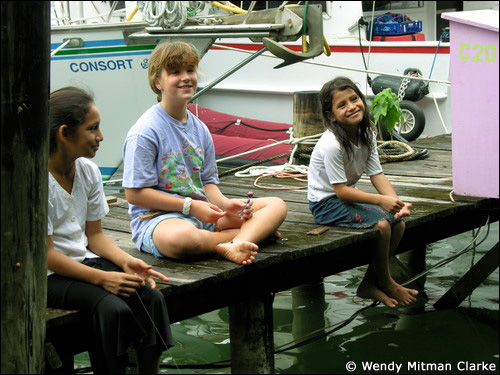 |
| Kailani fishing with her friends in Magdalena, Guatemala |
But the fact is, sometimes your schedules and itineraries just don't jibe. There are long periods when they don't have any other kids but each other. Our son is more philosophical about this. Our daughter, though, gets very lonely at times for other girls near her age.
That said, she is unafraid to go and make friends with local kids. Fishing is a great way to start a friendship, she has found, even if they don't speak the same language.
Both kids are very outgoing and always happy to play with kids of almost any age, even much younger ones. They use Skype whenever we have strong enough internet to call their friends in the States. Same with email. We go back once a year and during the time we are there I work hard to get them as much time as possible with their best buddies.
I'm not worried about their ability to socially interact with other cruising kids. My bigger concern is that if and when they do return to a “normal” land life, they will have had such experiences and be so much more mature than other kids their age they may have a hard time connecting.
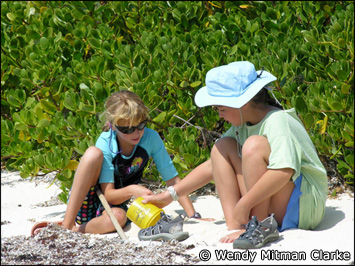 |
|
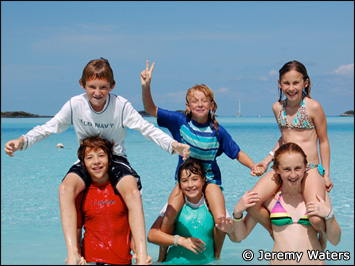 |
Kailani with her best cruising buddy,
Maddie Waters |
|
The kids with a bunch of cruising kid buddies
in Warderick Wells, Exumas |
Keeping the kids entertained
Easy.
First of all, they are excellent at entertaining themselves.
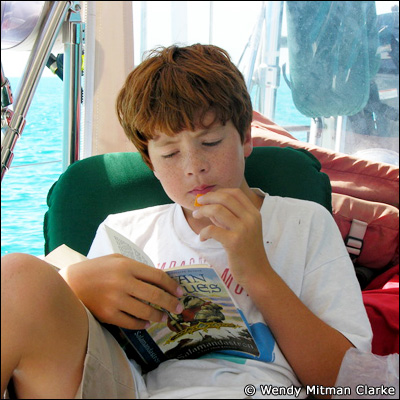 |
| Kaeo reading in the cockpit underway |
They read everything they can lay their mitts on, and our daughter loves all kinds of artwork—sculpting, painting, drawing, writing, sewing. She's always up to something like this. The hard part is finding places to put it all!
Our son enjoys building LEGOs and has a fairly good collection on the boat, though he had to leave a lot behind. We update his LEGO collection annually so he can constantly build new stuff. He enjoys two computer games, but that's about it for that.
He loves listening to the iPod, and we also have audio books and thousands of podcasts, from science shows to Sherlock Holmes mysteries. They have a portable DVD player for watching movies and favorite TV series out on DVD like Mythbusters and Deadliest Catch, and they share a laptop computer for that as well (that laptop is also the backup in case my husband's laptop, used for onboard navigation and communication, crashes).
They love swimming, snorkeling, hiking, playing on the beach, hanging out in the hammocks. My son loves sailing small dinghy-type boats, so anytime we can find one of those, he's in heaven Personal space aboard
Everybody needs their own safe haven onboard.
- The aft cabin is mine and Johnny's (although we certainly share it with the kids sometimes).
- The kids share a cabin forward, but they each have their own bunk, one above and one below, This gives them some privacy.
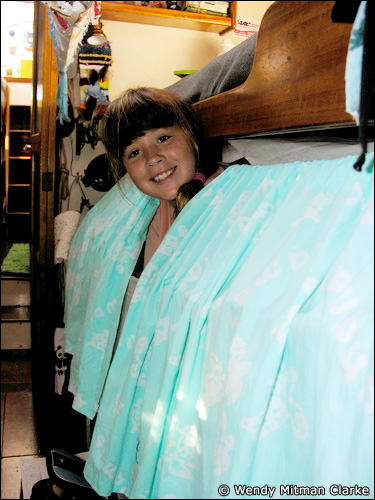 |
| Kailani in the "blue room" |
Last spring our daughter wanted curtains, so we picked out the material, a pretty turquoise batik, and I sewed them for her; she calls her bunk “the blue room” now. This fall we plan to brighten up the blue room even more by adding LED light strings.
We also let her paint and decorate her bunk any way she likes. She loves to paint, so I buy her small canvases, and when she paints something she really likes, we put it up in her bunk with Velcro. This way she can also change the paintings around, so she's not always seeing the same thing. She also has permission to just paint right on the wood if she wants. We have met families whose kids share a V-berth, which I think would be really hard, especially for a boy and girl, and absolutely for kids who are entering their teens as our kids are.
In a perfect world, each kid would have his and her own cabin, but we couldn't find a boat we could afford that offered that. So this shared cabin with separate bunks was a good compromise. The basic layout is good, but finding enough personal space is always a challenge, and for that I would love to own a multihull.
But we all talk about and have learned how to respect one another's need for space and quiet sometimes, and this is an important lesson a lot of people don't ever learn. The rules are based in one concept, and Aretha put it best: R-E-S-P-E-C-T. You treat everyone else's space as you would want your own treated. Family back home and their concerns
Some of my family members are very concerned about where we are sailing. They read the Internet and see reports of pirates and drug busts and all kinds of corruption and violence, as well as things like earthquakes, volcanoes, malaria, and dengue fever. True, all of those things exist where we are sailing presently (Central America). But many of them also exist in every neighborhood in the good old U.S. of A.
The best I can do to allay their fears is to tell them that we do our research, we are extremely careful in every choice we make, and we would never knowingly go into danger, either on land or at sea.
The hard part is how they define danger. Some people think hurtling down the Jersey Turnpike at 70 mph in a 2,000-pound automobile at rush hour surrounded by people who are doing the same is safe, while sailing peacefully alone in the middle of the ocean is dangerous. |